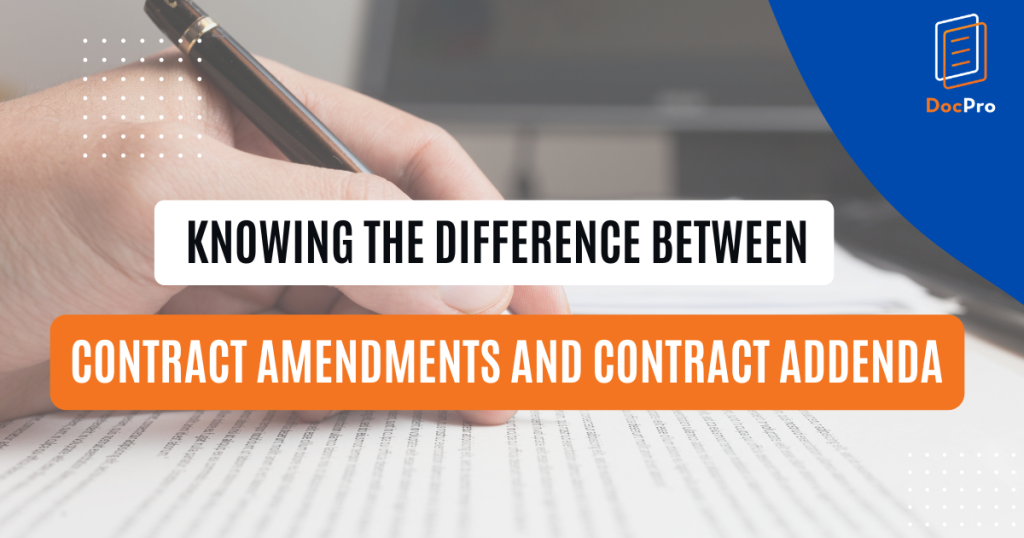Amendment Vs. Addendum - Most Important Differences Between Amendment and Addendum
22 Mar 2024
29 Jan 2024
min read

A contract amendment looks similar to a contract addendum on the surface. However, they are completely different when put into practical use. A contract amendment is a formal document for the purpose of altering or modifying an existing contract, while a contract addendum is a formal document providing additional terms and conditions to the original agreement.
To understand your options and make better-informed decisions, it is important that you know the differences between contract amendments and contract addenda. This article summaries key comparisons between these two document types and directs you to solutions provided by DocPro.
Difference between Contract Amendments and Contract Addenda
1 Nature
The word ‘addendum’ originates from Latin and can be translated as ‘something to be added’. A contract addendum is typically an attached, separate document adding or clarifying specific terms or clauses in the original contract. It may also include supplementary information that was not initially part of the original contract or agreement.
On the other hand, a contract amendment is a formal document altering or modifying existing terms or conditions in a contract or agreement. The word ‘amendment’, originated from the Latin word ‘emendare’, means ‘to correct, free from fault’. An amendment is usually used to change the original contract by replacing specific terms or provisions, while leaving the rest of the original document intact.
Addenda, unlike amendments, do not modify or alter the existing terms of a contract. Rather, they expend upon them. Addenda are typically used when parties wish to incorporate new details without disrupting the core elements of the original contract.
It is important to note that both amendments and addenda require the consent and agreement of all parties involved in the original contract to be legally enforceable. This means that while any party to the contract can propose an amendment of an addendum, it is necessary for all other parties to be aware of and agree to the proposed changes before an amendment or an addendum can be added. The process often involves negotiation and discussion among parties to reach a mutual understanding.

2 Timing and Application
To choose between an amendment and an addendum, many factors have to be considered. Below are some general circumstances when you should consider using an amendment, or an addendum.
2.1 Amendment(s)
Amendments are recommended in two general situations: (i) when substantial changes have to be made that affect the core content of the contract or (ii) when terms and conditions have to be updated for long-term contracts. More specific applications are summarized below:
- Updating the contract to accommodate new regulations: Legal rules and requirements are constantly changing. To comply with new guidelines, regulatory rules and business norms, parties can make use of contract amendments to accommodate such circumstantial changes.
- Adjusting the content of the original contract: Contract amendments are likely to be helpful when parties want to make changes to pricing terms, payment schedules and methods, as well as termination clauses and conditions. Such changes can be reflected via an amendment to accommodate changing needs within a contractual relationship.
- Changing major timelines of the contract/project: Parties may make use of contract amendments to reflect alterations in project deadlines and milestones, in order to render project management more efficient and effective.
2.2 Addenda
On the other hand, addenda are preferred when parties want to make relatively minor changes that do not impact the fundamental aspects of the contract. For example, the termination clause in an employment contract only outlines the conditions for termination as being death or voluntary resignation. In this scenario, a company may later decide to modify this clause via an addendum to specify additional duties and exceptions for employees. This allows for greater clarity and specificity within the employment contract and ensures that both parties are aware of the updated terms and conditions. Some more specific applications of addenda include:
- Correcting the content of the original contract: Parties may make use of contract addenda to fix mistakes or omissions that unintentionally happened during the initial contract drafting process, in order to better reflect their objectives and intentions, thus avoiding misunderstanding in the future.
- Including additional parties: In some situations, additional parties may have to be included in an existing agreement. Without changing the terms stipulated by original signations, the roles and responsibilities of these newly-included parties can be specified using an addendum.
- Extending the contract period: To prolong the life of an existing agreement, a contract addendum can be used as long as both parties are content with it and want to keep working together after the original expiration date.
3 Writing Contract Amendments and Addenda
After choosing the appropriate contractual document, an amendment, or an addendum, you may want to start drafting it properly. Here are step-by-step guides for you to tailor your amendment or addendum so as to reflect the contracting parties’ needs and intentions.
3.1 Drafting Amendments
- Step One - Identification: Pinpoint areas of the original contract or agreement that you want to alter or modify. Understand the scope and objective of such changes.
- Step Two - Drafting: Specify, using precise language, the changes to be made in specific clauses and terms of the original contract in the draft amendment.
- Step Three - Review: Render access of the draft amendment to all parties involved in the original contract. Allow time for them to review and give their consent to the modifications drafted. Document all feedback, negotiations and discussions, if any.
- Step Four - Signation: To render the finalized amendment legally enforceable, all parties involved should properly sign and date the document. Make sure each party keeps a copy of the amendment for future reference.
3.2 Drafting Addenda
- Step One - Identification: Identify the terms and clauses that have to be added to the original contract.
- Step Two - Drafting: State clearly, using precise language, the supplementary clauses and terms to be added in the draft addendum.
- Step Three - Review: Render access of the draft amendment to all parties involved in the original contract. Allow time for them to review and give their consent to the modifications drafted. Document all feedback, negotiations and discussions, if any.
- Step Four - Signation: To render the finalized addendum legally enforceable, all parties involved should properly sign and date the document. Make sure each party keeps a copy of the addendum for future reference and attach the finalized addendum to the original contract.

4 Advantages of Amendments/Addenda
4.1 Advantages of Amendments
There are a number of advantages in using contract amendments. The primary advantage is that writing an amendment instead of a new contract tends to be more efficient and cost-effective. Michael Callahan, trial lawyer and CEO at The Callahan Law Firm, believes that drafting a contract amendment is a simpler and quicker procedure than writing a brand-new contract. Since there is no need to renegotiate the entire contract, time and money can be saved [1].
Secondly, amendments allow comprehensive modifications as parties can make substantial changes by amending the contract, in order to cater to new requirements or circumstances. Amendments also allow parties to replace outdated clauses without having to draft a new contract from scratch. Furthermore, amendments assure great legal certainty, since changes to a contract or agreement are formally recorded, giving parties a precise and legally binding record of the new terms.
4.2 Advantages of Addenda
Though serving different purposes, addenda also carry multiple advantages on their own. Addenda provide great flexibility to parties by allowing them to make modifications to the contract without having to redo the entire document. This also saves much time and cost. Secondly, addenda ensure clarity of the contract as they can offer more information or clarifications on certain terms and provisions of the original agreement, avoiding future misunderstanding or disputes. Moreover, contract addenda are written in addition to the original contract, meaning original contract terms and provisions can be preserved. This safeguards the integrity of the original contract by leaving the essential clauses unaltered.
5 Summary
Here is a table summing up the major differences between a contract amendment and a contract addendum:
|
|
Amendments |
Addenda |
|
Nature of Documents |
Integral part of the main contract as they change its core terms
|
Supplementary to the main contract as they provide only additional clauses |
|
Nature of Changes |
Substantial or fundamental |
Supplementary and additional |
|
Scope |
Affect core elements of the original contract, such as pricing, delivery dates, termination conditions or responsibilities |
Focus on additional information or conditions that are not part of the original contract but are related to it |
|
Legal Significance and Status |
Carry significant legal weight and should be executed with the same formality as the original contract, often requiring signatures and witnesses |
Require formal execution with signatures, but are generally not as extensive in their legal impact as amendments |
|
Complexity |
More complex than contract addenda, as they may involve negotiating and drafting changes to multiple clauses or sections of the original contract |
Simpler and more straightforward, as they focus on specific, non-core aspects of the original contract |
|
Potential for Disputes |
Higher potential for disputes between parties if amendments are not executed precisely and clearly, because they affect core contract elements |
Lower potential for disputes because addenda only add supplementary information and are less likely to lead to disagreements as long as they are clear and well-drafted |
|
Legal Review |
Require a more extensive legal review because they can alter the legal rights and responsibilities of the parties significantly |
Require a simpler legal review as they typically do not change the fundamental legal framework of the original contract but only provide additional context |
Frequently Asked Questions
Q: Can an amendment be added to an addendum?
ANS: A contract amendment can be added to a pre-existing addendum. The process of amending a contract addendum is similar to that of submitting an amendment to a regular contract.
Q: Are verbally-made amendments and addenda legally enforceable?
ANS: Verbally-made amendments and addenda, like any verbally made contracts, can be legally enforceable. However, properly documenting the amendment or addendum helps reduce future misunderstanding and potential disputes.
Q: Is signation a must to render an amendment or an addendum legally enforceable?
ANS: Yes, for an amendment or an addendum to be legally binding, all parties involved in the original contract must agree to the changes, sign and date the document(s).
Q: Can an amendment be used to cancel a contract?
ANS: Generally, a separate termination agreement is needed to cancel a formal contract. An amendment, on the other hand, can only modify the original agreement but not cancel it.
Q: Which terms would be given precedence in times of conflict, those in an amendment or a contract?
ANS: Terms in an amendment usually take precedence and are given higher weight than those in a contract. However, it is important to specify this in the amendment (to the original contract) to avoid any legal ambiguity.

What DocPro Provides
Here at DocPro, we understand the needs of parties in accommodating the changing circumstances during the execution of contracts. Therefore, we provide simple and accessible solutions to contracting parties who wish to create an amendment or an addendum to their existing contract or agreement.
To access our template amendments and addenda, please visit the following pages:
- Amendment template for 2 parties --- Amendment Agreement of Agreement/Contract – 2 Parties
- Amendment template for 3 parties --- Amendment Agreement of Agreement/Contract – 3 Parties
- Lease amendment template --- Amendment to Lease
- Tenancy agreement amendment template --- Amendment to Tenancy Agreement
- Addendum template for property sale and purchase agreement --- Wrap Around Mortgage
[1] Michael Callahan, Trial Lawyer and CEO, The Callahan Law Firm
Keywords:
